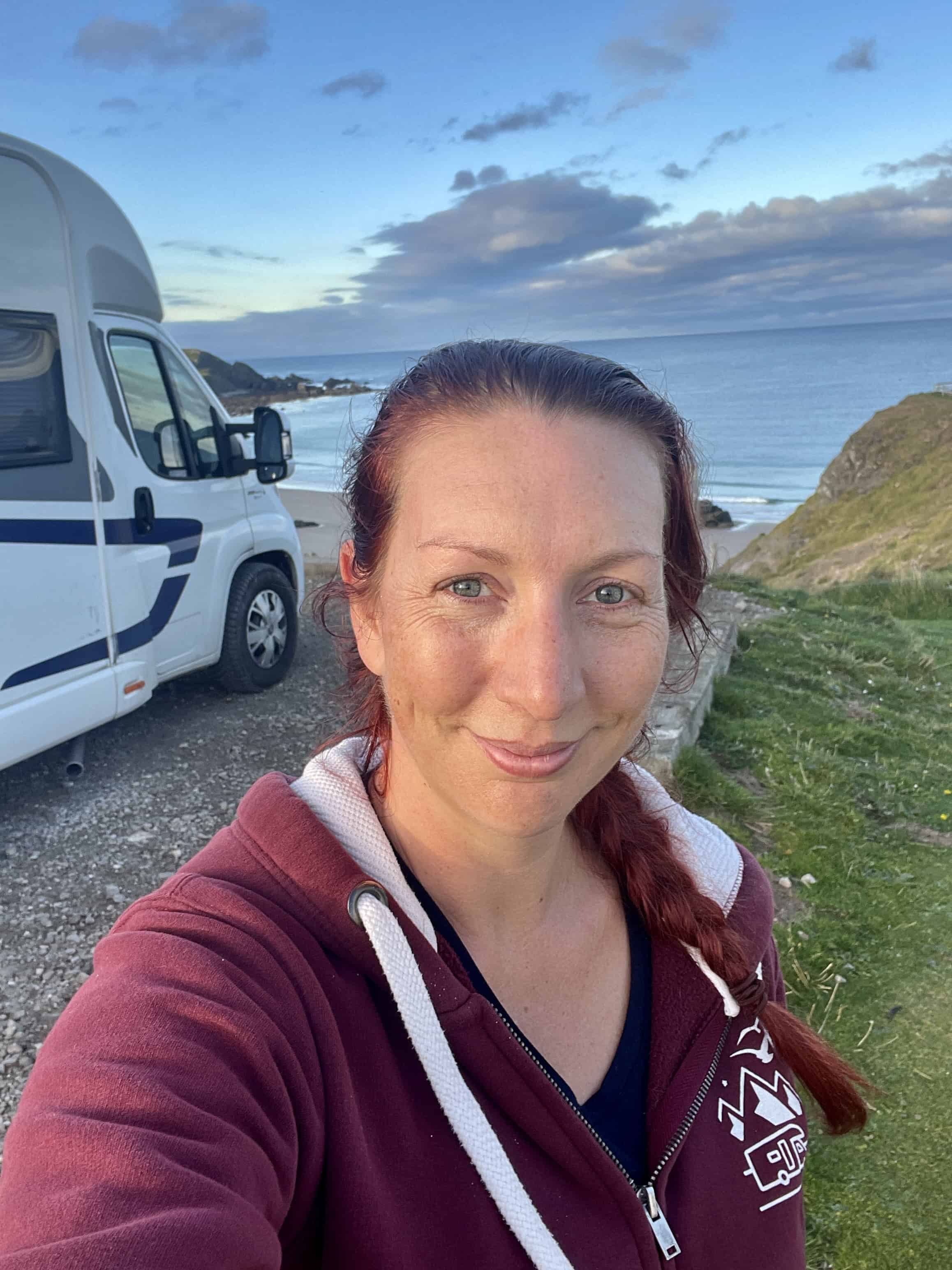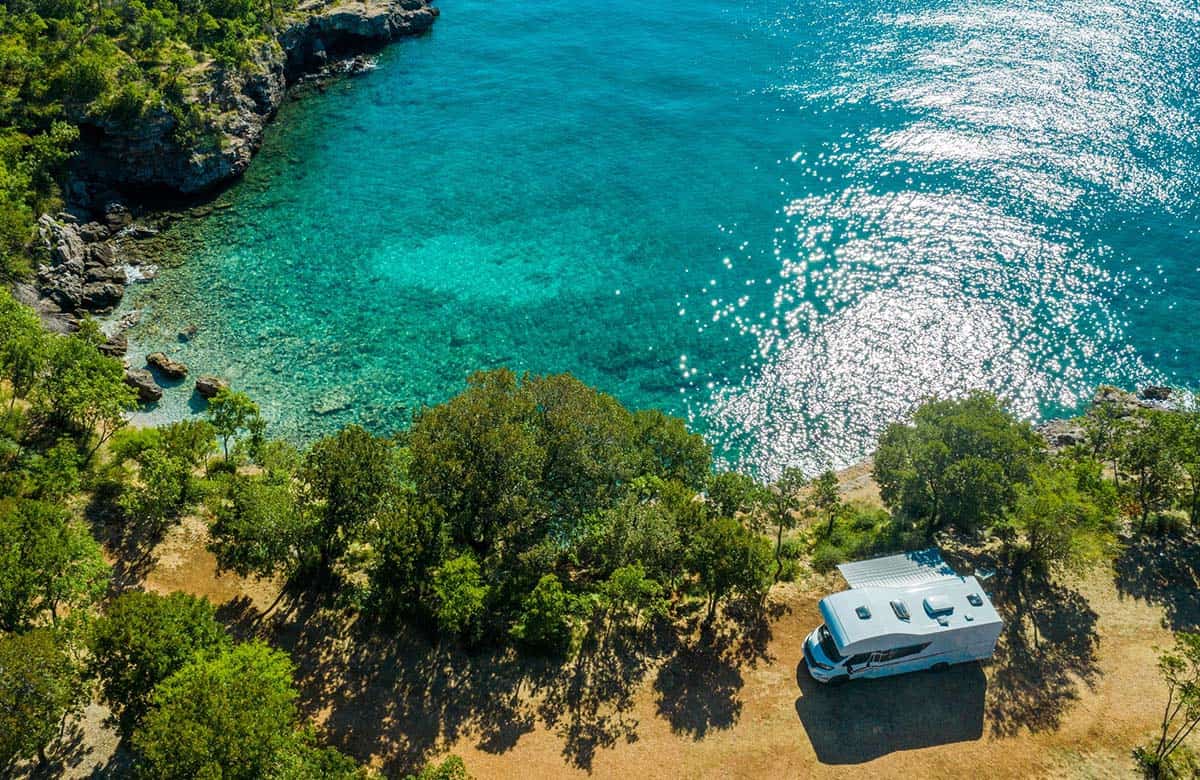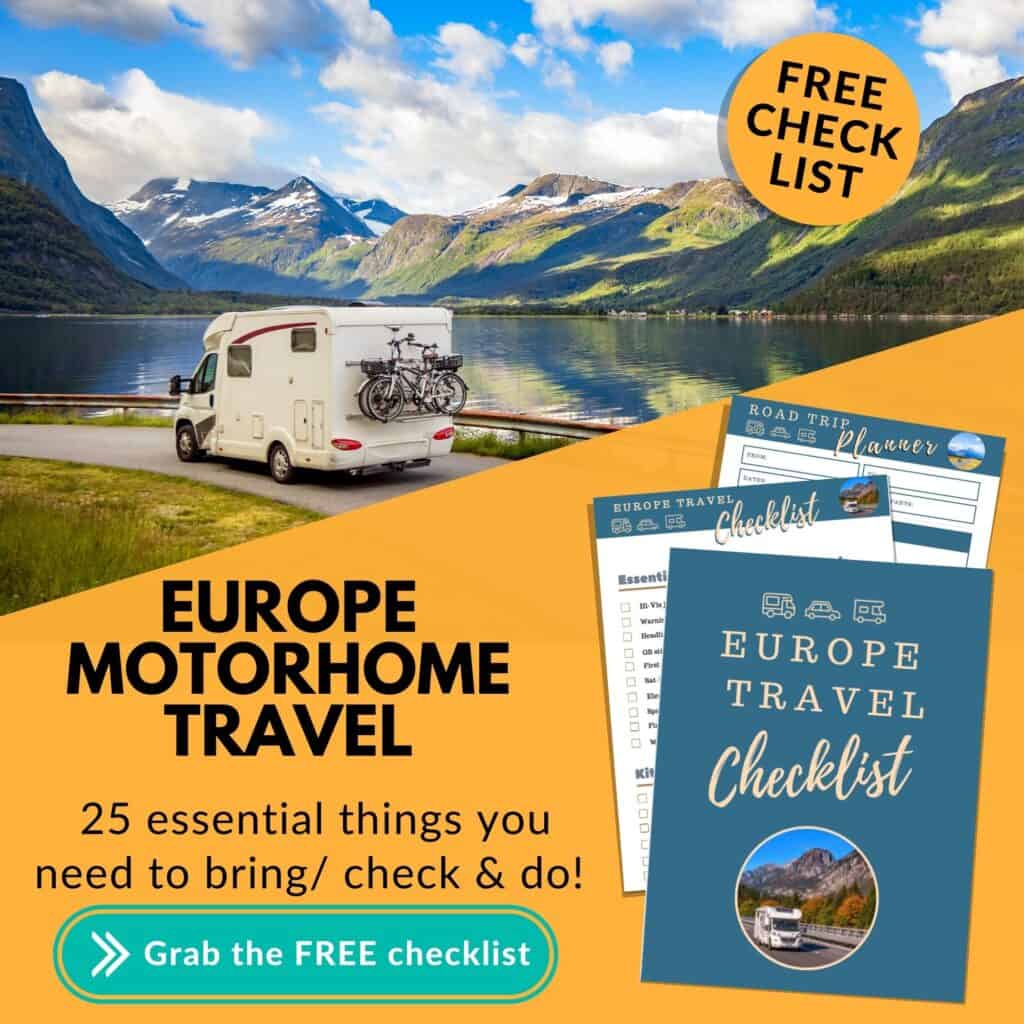Planning a motorhome or campervan tour of Croatia? Lucky you- Croatia is a fabulous place to visit for vanlife. Here’s everything you need to know about motorhoming and campervanning in Croatia, including routes and some best places to visit.
Don’t forget to download your FREE Europe motorhoming checklist to help you plan your Croatia trip.
*We work hard to make this the best motorhome blog and road trip website possible, full of helpful content for you. The website is supported by our readers, so if you buy through links on this site we may earn a commission- at no extra cost to you. All opinions remain our own.
If you find this post useful, you can also treat us to a coffee at the bottom of this page- we promise to enjoy it while creating more useful content like this- we might even indulge in a biscuit (or two!)
Motorhoming in Croatia – why you should go!
Croatia is possibly motorhoming heaven. lt has a little bit of everything- fantastic coastline with sandy beaches, islands, mountains, friendly people and sunshine. Lots and lots of sunshine.
Despite having some modern cities, most of it still feels far away from the world- the perfect place to relax and unwind.
One of the best things about being able to explore Croatia on a European motorhome tour is that you can see the differences between the regions, try the local cuisine (and wine!) and really get a feel for the country in a short space of time.
It’s also one of the cheapest countries in Europe and motorhome wild camping is possible (if not strictly legal- more on that shortly), so you can travel on a small budget without much issue.
In this guide, we’re going to share with you everything you need to know to go motorhoming or campervanning in Croatia, including getting to Croatia and planning your route, where to stay (motorhome campsites, aires or wild camping with your camper), some road trip ideas and places to visit, driving tips and other practical advice to help you have an amazing Croatian road trip.
We’re also going to share some things NOT to do!
If this is your first campervanning trip to Croatia (or Europe!), don’t forget to grab your free motorhome travel checklist which will help you plan and organise everything you need.
Campervanning in Croatia- Where to go
When planning a motorhome trip to Croatia, the first thing you need to do is decide where you’re going (and how long you have for your adventure!)
How long to go for?
If you’re driving from the UK to Croatia (we’ll cover that shortly), you need to allow at least 2 days (probably 3) to get from arriving in France (by either ferry or Eurotunnel) to Croatia.
And that’s 3 days of pretty much solid driving (it’s just over 15 hours (900 miles) from Calais to the north-western Croatian border.) Bizarrely, it’s actually slightly quicker to go campervanning in Croatia than it is to go campervanning in Portugal!
We don’t recommend visiting Croatia if you only have a week or your road trip. It’s too far and all you’ll do is drive there and back. Of course, if you’re going to rent a motorhome and fly in, that’s perfectly doable in a week (more on that shortly).
We explored a lot in only 4 days (we had a two week trip, but we got sidetracked by the Italian Dolomites and then Slovenia!)
If you have a couple of weeks, you can certainly explore a good chunk of Croatia, but you will be doing a lot of driving unless you stick to just the North of the country.
Croatia isn’t a huge country- it only takes about 7 hours (370miles) to drive from North to South, but it’s a weird shape and once you’re down in Dubrovnik you have to head north a long way to get further east, unless you choose to cut through Bosnia.
Highlights of a Croatian Motorhoming Holiday
Some of the best places to visit when enjoying van life in Croatia include:
- Plitvice Lakes (go early!)
- The hidden shipwreck cove (see that here)
- Zadar and the sea organ
- Krka Lakes
- Dubrovnik old town (think Game of Thrones)
- Pula cave
If you enjoy reading books before a trip, here are some we recommend:
See more fun and practical motorhoming books we recommend reading
When to go motorhome touring in Croatia
Croatia is lucky enough to have a wonderful climate for most of the year, although it can get HOT in summer.
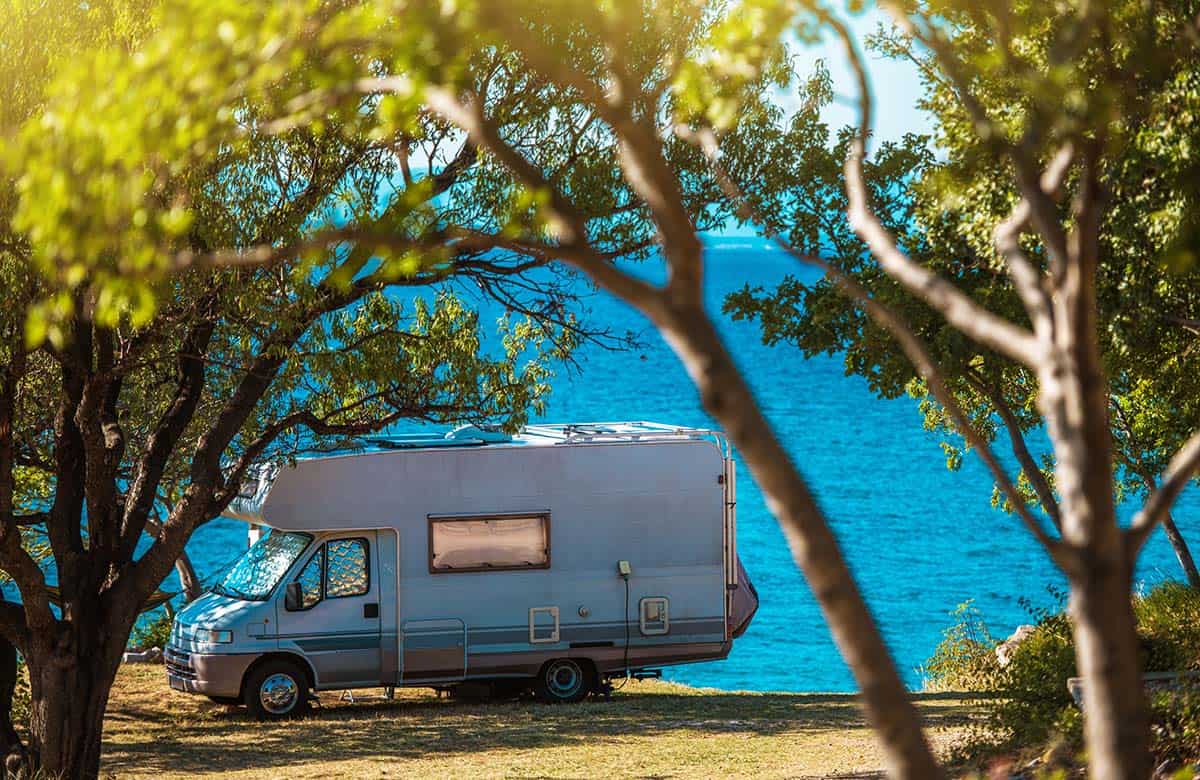
Campervanning in Croatia in winter
Surprisingly, Croatia is COLD in winter. Average temperatures go down to around 10c between December and January. They warm up slightly in February (making it almost one of the warmest places in Europe in February with average temperatures of over 12°C.)
Many campsites and tourist locations do close for winter, although there are still a few open all year for you to enjoy.
Touring Croatia in summer
For us, summer in Croatia is too hot and humid. The average temperature in August is 30°C. As we don’t have air conditioning in our motorhome, and because we travel with a dog, we try to avoid hot places like this and go motorhoming in Norway or other places with mountains and cooler air.
Also, it gets crowded in summer. Crazy crazy crowded. Beaches are packed and queues for tourist attractions are long. Being crammed in, in hot weather, doesn’t appeal to us at all.
Motorhoming in Croatia in Spring and Autumn
As with most of Europe, Spring and Autumn are perfect times to explore Croatia. The weather is still warm (average of 18°C in May and 20°C in October), but most of the crowds from summer have gone and you might even get stretches of beach all to yourself.
TOP TIP: If you are travelling outside of peak season, definitely get an ACSI CampingCard– you’ll save a fortune on campsites all over Europe, including Croatia
Planning a driving route from the UK to Croatia
If you’re planning a campervanning trip to Croatia, there are a couple of options from the UK, assuming you’re bringing your own vehicle (if you’re flying in and hiring, we’ll deal with that shortly.)
If you’re going to drive directly from the UK to Croatia, the quickest route is to turn left from Calais and head through Belgium, then Germany and down through Austria.
However, if you have more time, many people choose to head to Italy with their motorhome, then catch a ferry across the Adriatic Sea.
Borders / Customs in Croatia
You will have to cross a border to get into Croatia. Here, you will need to show:
- Your passport
- Proof of a negative COVID test (or proof of vaccination)
You also need to have completed an online form before arrival. Make sure you are in the correct lane at the border (there are different ones for EU, Swiss and other residents.) Your passport may be stamped on entry/ exit. If it is stamped on entry, make sure you get an exit stamp.
You may also need to:
- show a return or onward ticket
- Have proof of accommodation (not usually asked for if you’re in a motorhome or campervan.)
- show you have enough money for your stay
Is Croatia in the Schengen Area?
As of 01 January 2023, Croatia IS IN the Schengen area, and therefore time spent in the country counts towards your 90-day travel limit. (if you are a UK resident.)
Hiring a motorhome to tour Croatia
If you don’t have your own vehicle, or don’t have time to drive all the way to Croatia, you can easily fly in and hire one. Just make sure to ask how to get from the airport to the rental agency- not all of them are at the airport itself and you might need to book a taxi.
To rent a vehicle in Croatia you must:
- be over 21 or 25 years old, depending on the company’s rental policy;
- show identification (identity card for EU citizens or a valid passport for other nationalities)
- have had a driving licence for more than one year
Make sure you have proof that you can take the vehicle across a border into another country if that’s what you’re planning to do. Read the article below for other things to check as well before you agree to hire.
Don’t forget, it is YOUR responsibility to make sure the vehicle has the required safety equipment. The on-the-spot fines apply to you as the driver, not the company. Check in advance with the company what kit they will provide with the vehicle and what you will need to bring.
Take a list of what is legally required with you and check it off one by one as you are given the handover. Do not drive until you are happy you comply with the local laws.
You can expect to pay around £70/ day- be sure to ask the right questions so you know what to expect from your motorhome or campervan rental
Motorhoming in Croatia- what gear do you need to carry?
Just like most of Europe , there are certain things you MUST carry with you in your motorhome or campervan whilst touring in Croatia.
Don’t forget, if you are driving through France and/ or Germany to get to Croatia, you need all the kit required by those countries, as well as the kit needed in Croatia. (Luckily, if you’re used to motorhoming in France, you’ll have pretty much everything you need already)
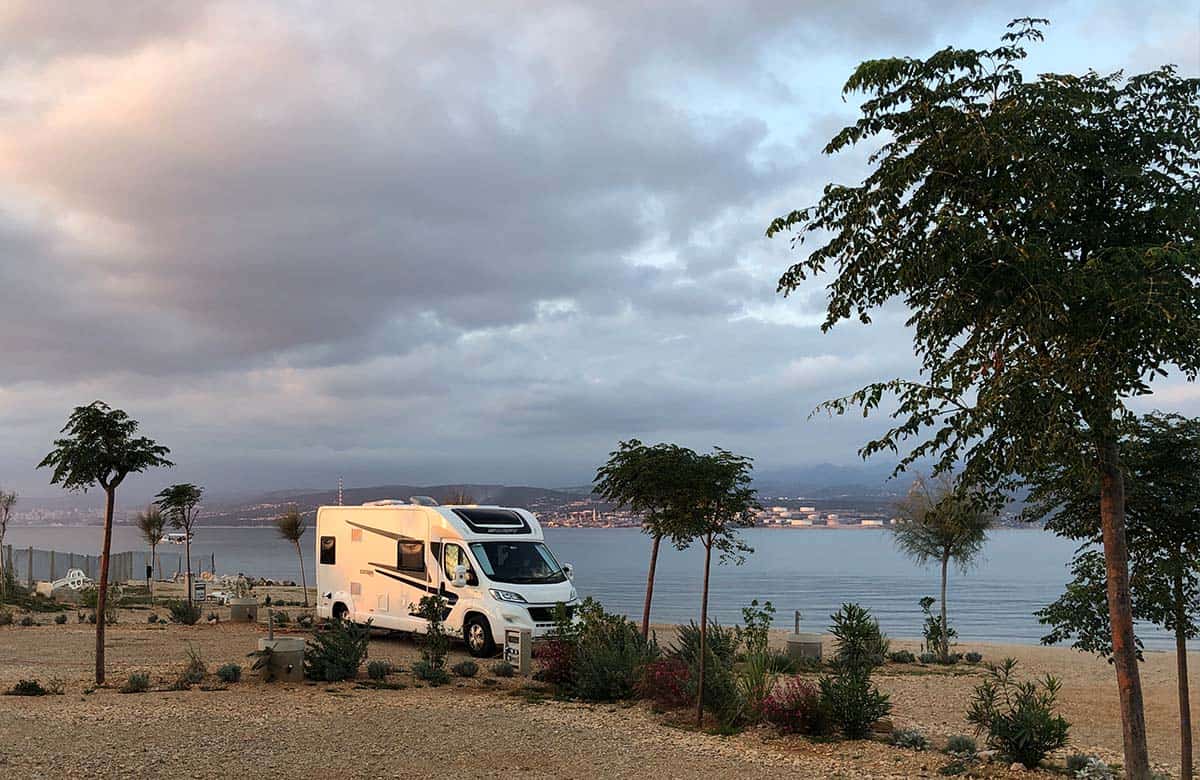
Things you need to drive in Croatia- safety gear
These are the things you MUST have with you when you’re motorhome or campervan touring in Croatia.
- Hi-vis reflective jackets – not as strict as in France, but you must wear them on the side of the road or hard shoulder or risk being fined.
- Warning triangle
- Headlight beam converters– if you have a UK vehicle. These must be fitted before you drive in Europe. (If you have a vehicle which allows you to adjust the beam automatically for European driving, you won’t need these.)
- UK sticker attached to the back of vehicle or reg plates (and trailer if you have one)
- A spare wheel (and tools to change it!), or a tyre repair kit.
- If you wear glasses you MUST carry a spare pair
TOP TIP: Buy these essentials for driving in Croatia in advance. If you wait until you’re at the ferry/ tunnel, you could spend THREE times as much! See the latest deals and best prices here
NOTE: Motorhomes and cars towing caravans are not allowed to exceed 12m in length, 4m in height and 2.55m in width. Loads must not exceed 11.5 tonnes at the drive axle and 10 tonnes at a single axle.
A-frames are not legal for use by UK campers and caravanners abroad. So if you tow a vehicle, you’ll need some sort of trailer.
Road trip accessories you MIGHT need when campervanning in Croatia
The following kit are things you might need to carry in your car, motorhome, caravan or campervan, depending on when you are planning your road trip in Croatia.
You will probably want an automatic toll tag- as many of the motorways insist on them before you can use the road. You can avoid these, but it’s a lot of extra driving. More on that in the ‘toll’ section.
- Winter tyres & snow chains are mandatory where signage indicates.
- Red/ white warning board sign – for bike racks or anything overhanging the end of the motorhome or campervan. Lines must point into the middle of the road. Again, this is not legal requirement in Croatia, but worth having anyway.
- First aid kit – not compulsory but worth carrying. Find out what we carry in our European first aid kit here
- Spare bulbs for all lights in the vehicle
- Torch
- Fire extinguisher
- Road Trip snacks and water- just in case!
What documents do you need to road trip in Croatia?
If you’re driving in Croatia, you need to carry the following documents:
- Passport (or identity card)
- Driving licence (check it is in date!)
- Motorhome Insurance documents- check you are covered for driving in Europe
- Breakdown cover
- Vehicle V5 logbook (which must show your correct address)
- Vehicle must be legally taxed and MOT’d
- Trailer certification
- International Driving Permit if required
- Personal travel insurance
Do I need an international driving permit to drive in Croatia?
Most UK citizens do not need an IDP to drive in Croatia, as long as you have a card driving licence issued in the UK (in date, of course!)
You might need one if you have:
- a paper driving licence only
- a licence issued in Gibraltar, Guernsey, Jersey or the Isle of Man
(If you do need an IDP, here’s an in-depth guide on how to get an International Driving Permit and which one(s) you need from a UK post office.
From 2nd August 2021, drivers will no longer require an insurance green card for taking their vehicles to Croatia.
Touring Croatia in a campervan- Other useful things you might need
We’ve been touring Europe in our motorhome for several years. We’ve tried all sorts of kit- some useful, some not so much.
Here is a list of things we highly recommend when motorhoming in Croatia, but which are NOT essential:
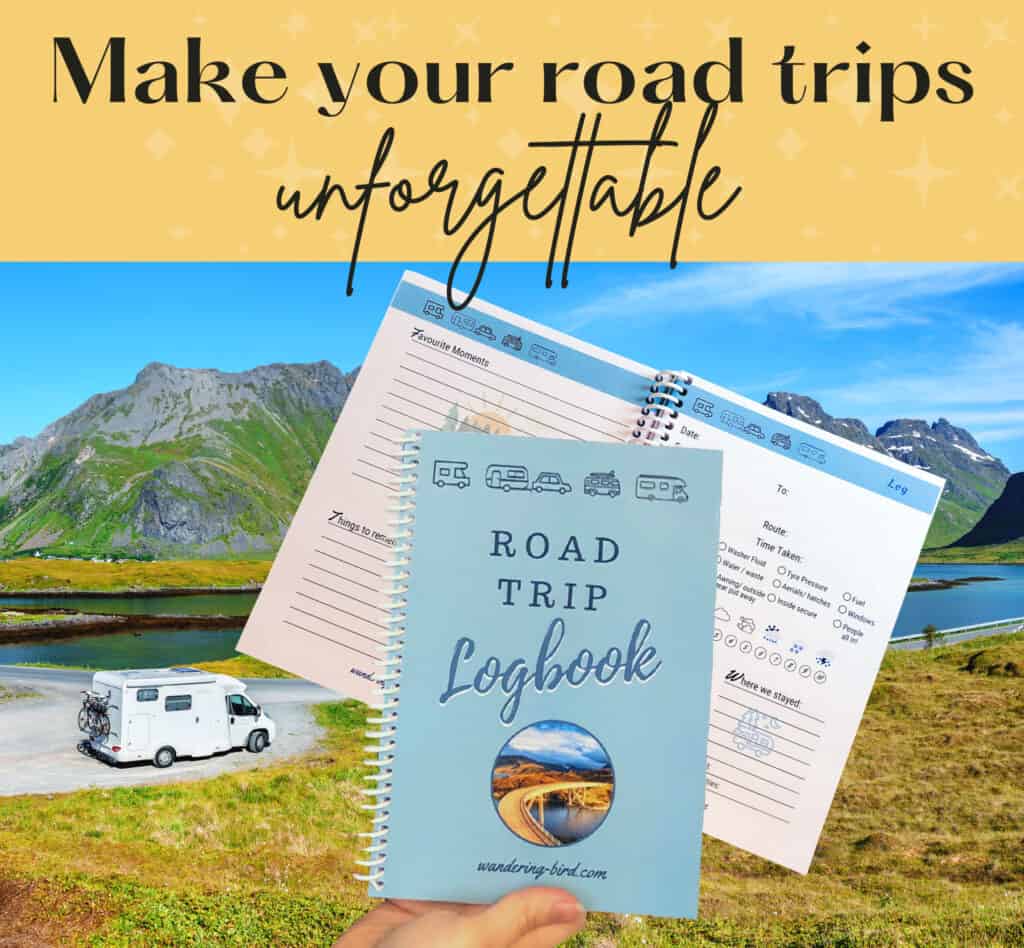
What can you NOT take into Croatia?
You cannot take the following with you into Croatia:
- meat or products containing meat
- milk or dairy products
In all honesty, we had tins with meat in them and meat and cheese in the fridge, plus dog food and we weren’t searched, so I wouldn’t worry about it too much.
There’s also some talk saying fresh fruit and vegetables need a certificate but, again, we had these in the fridge and weren’t asked or searched.
Motorhome stopovers & overnight parking in Croatia
In Croatia, there are several types of motorhome and campervan stopovers you can use.
- Campsites
- Aires (very few)
- Approved motorhome parking schemes
Croatia Camping sites for motorhomes, campervans and caravans
It’s easy to find motorhome campsites in Croatia and they’re much like campsites anywhere else in Europe. Some are rustic and have very basic facilities, while others are designed for long-term visitors and have entertainment, clubs, pools and bars!
Many campsites have large pitches, excellent (and clean) facilities and stunning views. And most have staff who speak excellent English. Our favourite campsite was right on the beach- it was utterly magical.
Expect the campsite to take and keep your passport- the Camping Card International isn’t used here so you need to hand over your passport.
TOP TIP: If you’re touring Croatia in summer, make sure to get a pitch with shade. You’re going to need it when the sun gets hot!
Many campsites have either long-term residents who live in their motorhomes in Croatia, or have permanent statics or caravans which the owners visit when they can.
If you’re travelling out of high season and are planning to use campsites, we highly recommend buying an ACSI CampingCard membership, but be aware that some campsites either shut during the winter or are booked up entirely months in advance, so you may wish to book one too.
Also, many campsites put ACSI users on ‘lesser’ pitches (either bad view or no electric or drainage). You can ask for a different pitch, but will usually need to pay a supplement which wipes out the ACSI discount!
At some campsites, you will need to pay extra for shower or electric usage. Be warned- the hot water in the shower is on a timer- usually between 3-5 minutes per token.
TOP TIP: If you’re planning to stay in one area for a long time (30+ days), negotiate a special rate with the campsite directly. Most of them have some sort of discount- some are as little as £10/ day, including electric.
Aires in Croatia
Aires are approved motorhome overnight parking places- often provided and maintained by the local commune.
You cannot book motorhome aires in advance- it’s first-come, first-served, so if you’re visiting at peak times you might feel happier booking a campsite so you’re assured of somewhere to stay.
There are very very few aires in Croatia and they’re often a little more out of the way.
Some campsites do allow motorhomes to park up outside their main campsite, with no facilities, but they still charge for this.
READ MORE: Learn how we find and use aires and approved free overnight motorhome stopovers across Europe
There are very few facilities at an aire. You should be able to get water and empty waste, but don’t expect restaurants, pools or entertainment areas. Also, do not hang out washing, get your awning out or put chairs out- this is camping and is not allowed- the police will stop and ask you to move.
If you want to use aires in other countries, it’s always worth investing in a book of aires, as well as an online app- just in case you find yourself without internet in your motorhome (or without a wifi signal). Of course, the downside with any book is that it goes out of date, but don’t worry if it’s only a year or two out- most information about aires won’t change too much.
Here are some we recommend:
Is wild camping / free camping legal in Croatia for campervans and motorhomes?
Nope. It is not legal to wild camp with a motorhome or campervan in Croatia. Apparently, this is due to the possibility of land mines being left behind after the war in the 1990s. Personally, we chose to use campsites, although we did choose cheap campsites, which were almost like aires with very limited facilities.
There are many places listed on Park4night for wild camping, but there is a fine if you are caught (around £350). So it’s up to you if you want to risk it.
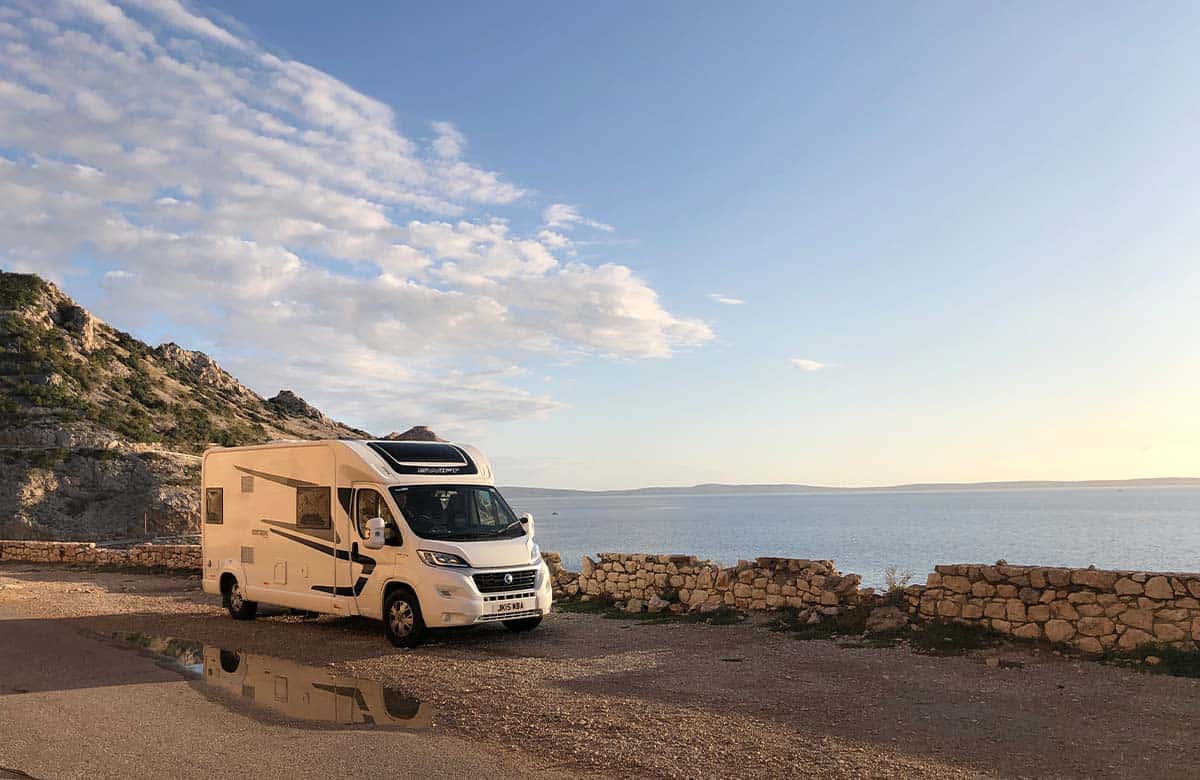
Motorhome and campervan service points in Croatia
There are a few motorhome service areas around the country, but not as many as you might hope for, probably because campsites are so highly used. If you are planning to stay off-grid, we recommend booking into a campsite every few nights to use their facilities.
Driving tips for Croatia
Driving in Croatia isn’t actually that bad. The roads are fairly good (even the coast roads) and the drivers are slightly more sensible than the Italians- although their attitude to health and safety is much different to ours! Signs are clear and it’s pretty easy to navigate.
There are several motorways – denoted by a ‘A’ followed by two digits. They have a green background with a picture of motorway in white. State roads have the letter D and country roads have the letter Z followed by four digits.
The main motorway south to Dubrovnik has been built as far as Ploce (about 100km north of Dubrovnik). Don’t forget, this was a war-torn country 30 years ago and they’re still rebuilding/ updating.
The prettiest route in Croatia is definitely the Adriatic road (Jadranska magistrala – officially road D8) which connects Rijeka and Dubrovnik. It’s definitely worth driving and is perfectly doable with a motorhome.
Ok, let’s deal with the basic rules and some tips for motorhoming and road tripping in Croatia:
- Croatia drives on the right
- Seatbelts are compulsory
- Speeds are in km/h, not mph (you might want to change the setting on your motorhome sat-nav)
- UK or EU-issued disabled permits should be recognised in Croatia.
- Vehicles already on a roundabout have right of way (so do all public transport vehicles and school buses.)
- Illegally-parked vehicles are likely to be clamped and a fine must be paid to have the vehicle released. There was motorhome parking in Zagreb, but not sure about other cities
- You might here horns a LOT- drivers use them to greet each other
- Using a mobile phone while driving is prohibited unless you have a hands free device.
- Between the end of October and the end of March dipped headlights should be used during daylight hours.
- Winter tyres are required from November to March, and it is compulsory to carry a shovel during that time
- Road surfaces are generally pretty good in towns and cities, but can be bad in the countryside.
- Emergency vehicles and military vehicles have priority over other road users.
- Children under the age of 12 cannot sit in the front seat of a vehicle
- If you’re motorcycling in Croatia, helmets ARE compulsory
- Bicycle helmets are not compulsory in Croatia unless the rider is under the age of 16.
- Cyclists riding at night must wear a reflective jacket.
Speed Limits in Croatia (unless otherwise signed!)
Breaking the speed limit could result in either an on-the-spot or an automatic fine being sent to you.
Cars and vehicles under 3.5 tonnes:
- 130 km/h (81mph) on motorways and some dual carriageways
- 90 km/h (55 mph) on minor roads (out of town)
- 50 km/h (31 mph) in built-up areas
Motorhomes and Campervans weighing over 3.5 tonnes:
- major roads/ motorways 90 km/h (55 mph)
- minor out-of-town roads 80 km/h (50 mph)
- urban areas- 50 km/h (31 mph)
Motorhomes with trailers or caravans (under 3.5t)
- major roads/ motorways 90 km/h (55 mph)
- minor out-of-town roads 80 km/h (50 mph)
- urban areas- 50 km/h (31 mph)
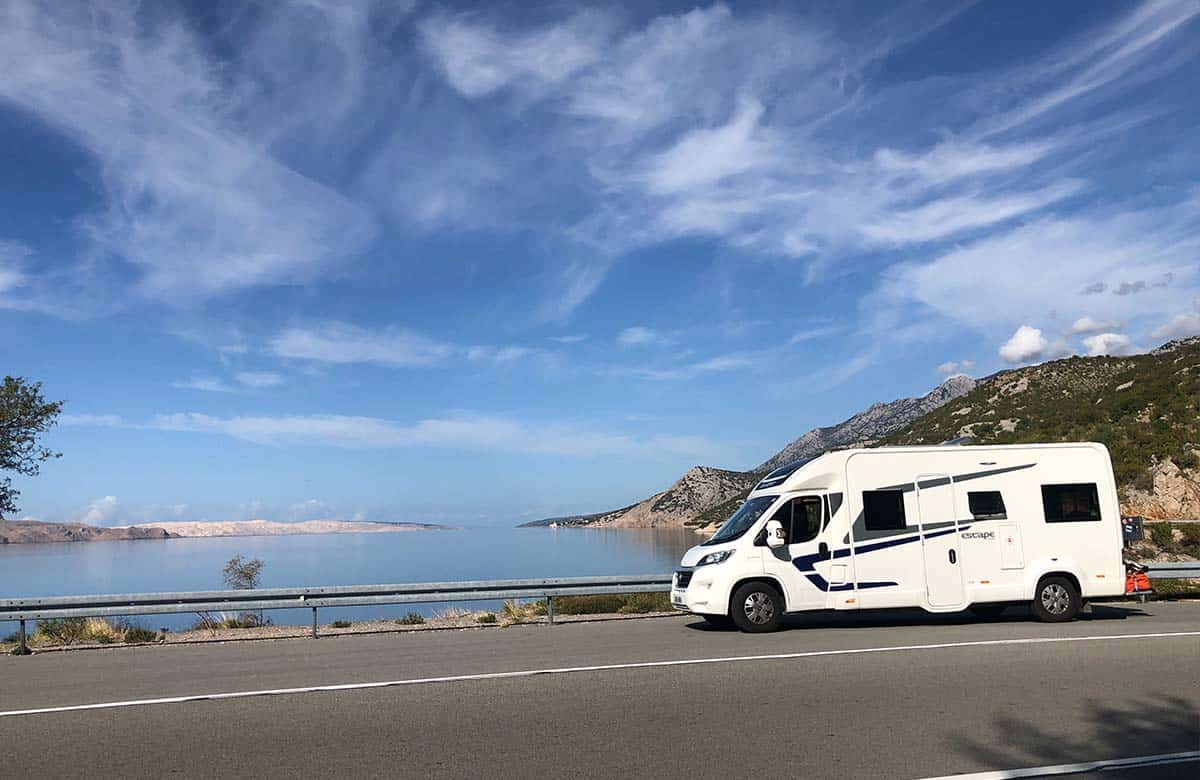
Speed Cameras in Croatia
There are now a few speed cameras operating in Croatia, but mainly its marked or unmarked cars who monitor speed and fine you.
Drink Drive law in Croatia
Alcohol laws are stricter in Croatia than the UK. The legal limit is 0.05% blood alcohol (the UK is 0.08%)
For professional drivers (driving a bus, coach, HGV or public service vehicle), as well as for drivers under the age of 24, the limit is 0.00%.
Low Emission zones in Croatia
Currently, Croatia has no low-emission zones.
Click here for more detailed information about how to find zones across Europe.
Tolls in Croatia
Most motorways in Croatia have tolls. You can pay for them with cash or a credit card and some even accept foreign currencies like the Euro.
There is a pre-paid SMART card system which provides a 10% discount on toll charges, although motorists must register ahead of time to use this system.
The toll system is very easy to use. When you enter, you take a ticket from the toll booth machine. When exiting, you hand over your ticket (so don’t lose it) and pay for the distance that you have travelled.
Toll fees can be paid in cash (Kunas, or occasionally Euros) as well as by debit/credit card. The fee is based upon the size of your vehicle
Toll charges only exist on motorways in Croatia. Driving on all other roads does not incur any charges or payments.
More useful things to know when campervanning in Croatia
Petrol and Diesel
Petrol and diesel are widely available. Many fuel stations are 24h on the main roads and are self-service with card machines.
Petrol is Gasoline (Eurosuper) (95 / 98) – Usually Green handles on pump
Diesel is EuroDiesel. Usually Black or yellow handles on pump (there is also ‘diesel’, which may be cheaper but is apparently lower quality)
Some places are 24h pay at the pump, but may require you to go into the shop and pay the cashier either in advance or after you’ve filled up- there will be a sign to tell you what to do. (Leave your car in front of the pump and make a note of the pump number.)
You can pay using cash or a credit card. Many places do NOT take American Express. You can usually use your UK cards without a problem.
LPG Gas
LPG (GPL) can be found at many petrol stations. If buying from a petrol station, you may need to wait for an attendant to turn the system on for you.
You can find places which sell LPG using MyLPG.eu
Remember, if you don’t have refillable gas bottles, you will be unable to buy a gas bottle which fits straight onto a UK system- you need a new pigtail.
READ MORE: How we find motorhome LPG or bottles while touring Europe
Campervanning in Croatia- security
There is a fairly high crime rate in Croatia, so we highly recommend paying extra attention to your motorhome security. You might even wish to fit an extra camper habitation door lock and never leave your vehicle unattended in an unsecure area.
READ MORE: Essential tips for protecting your van at home and on the road
More useful things to know about vanlife in Croatia
Some more tips to help you enjoy your time in Croatia.
Emergency Numbers: 112 will get you everything
Language– The Croatians are pretty good at languages. Croatian is the official language, but many also speak Bosnian, Serbian and many of the younger generation speak English well.
Currency– Kuna
Cards– most major credit and debit cards are accepted. American Express is only taken in large stores (not at tolls and often not at fuel stations)
Timezone– GMT+1 (or one hour ahead in BST)
Mobile Phone and Internet – It’s usually possible to use your UK phone and data in Croatia, but do check with your provider.
Tipping- Tipping up to 10%, but you can go up to 15% in restaurants if you are particularly happy with the service.
Shops– Food prices are pretty inexpensive. Traditionally, shops are open from Monday to Friday, from 9 or 10 a.m. to 7 p.m. Some close for lunch from 1 to 3 p.m. On Saturdays, shops generally close at 1 p.m. though in city centres some are open in the afternoon. Many shops close on Sundays. Bigger supermarkets may be open, but will close at lunchtime.
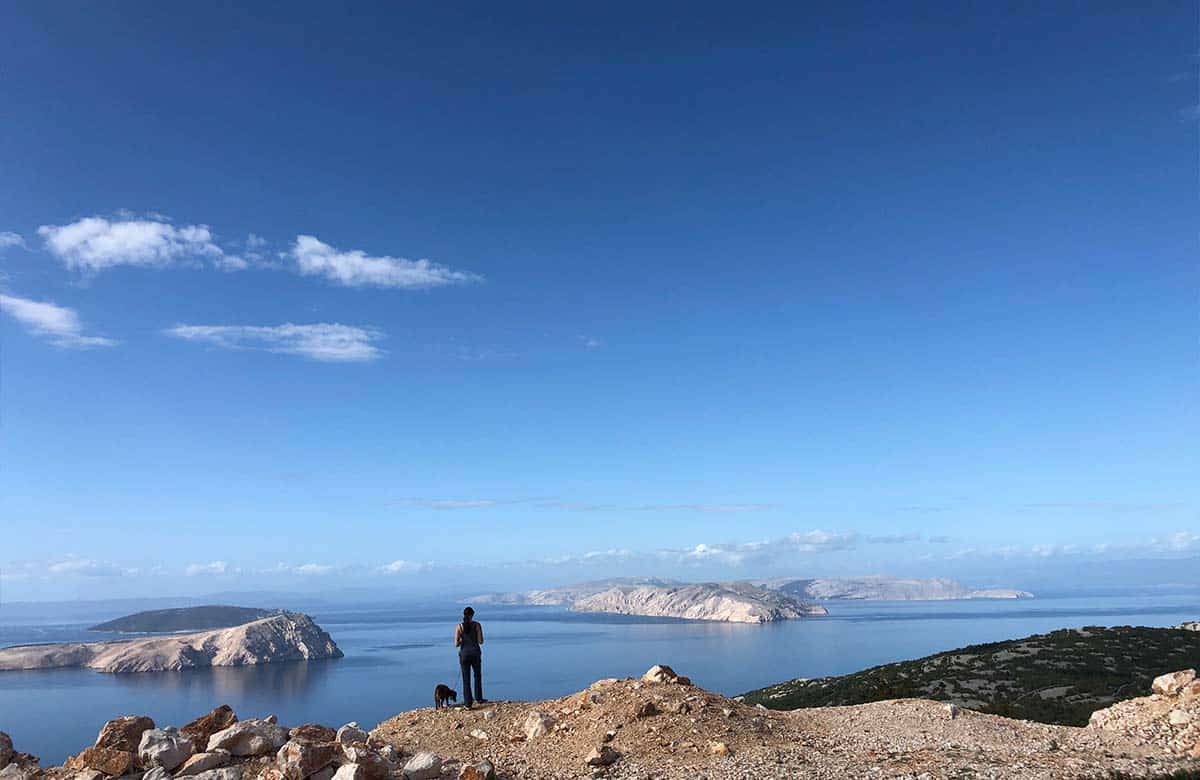
Touring Croatia with a dog
Croatia is slowly becoming more dog-friendly (if you’re used to motorhoming in Germany it’s not at that level yet) but they are welcome in many places, such as at the Plitvice lakes (you can see Mac at the lakes here.) Many restaurants allow them- just ask before entering to be sure.
Read more: changes affecting travelling to Europe with a dog after BREXIT
They are not allowed on many beaches in summer and are not allowed into public places like shops but are usually allowed on public transport (you might need to muzzle larger dogs.)
Don’t forget how hot it gets in summer and to make sure your dog is comfortable. Do NOT leave them in your motorhome or camper on a sunny day- vans heat up just like cars do. Here are some tips to keep your dog cool on a road trip.
To return into the UK you’ll need a vet on the continent to administer a worming treatment and then allow between 24 hours and 5 days before re-entering the UK.
Using a drone in Croatia
You are allowed to fly your drone in Croatia, but Croatia is part of the EU follows the drone regulations put in place by the European Union Aviation Safety Agency (EASA). You must also:
- Stay a safe distance away from people.
- Do not operate directly over people unless it has a class identification label or is lighter than 250 g (0.55 lbs).
- Maintain a visual line of sight
- Do not operate the drone above 120m (400ft).
- Do not carry any dangerous goods or drop any material.
- Maintain a radius of at least 5 km from an aerodrome up to 50 m above the surface.
- Do not operate more than one drone at a time.
- Do not fly within the area in which emergency response effort is being conducted.
